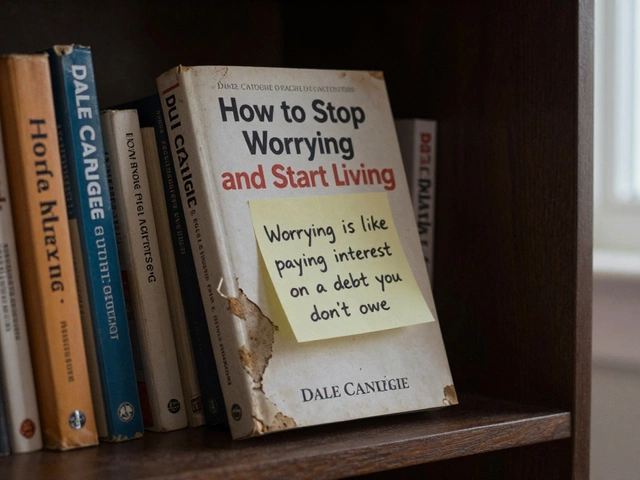Note-Taking Method Recommender
Find Your Perfect Note-Taking Style
Answer these quick questions to discover which method works best for your self-help reading habits
Recommended Method
Pro tip:
Ever finished a self‑help bestseller only to forget most of its advice a week later? You’re not alone. The real test of any personal‑development read is whether its ideas stick and show up in your daily habits. That’s where note‑taking enters the conversation. Below we break down if taking notes from self‑help books actually boosts retention, what methods work best, and how to turn a fleeting insight into lasting change.
Key Takeaways
- Note‑taking activates recall pathways, making ideas from self‑help books easier to remember.
- Handwritten notes improve focus, while digital tools add searchability and flexibility.
- Pair notes with an action step to bridge the gap between insight and habit.
- Use a simple system - headline, takeaway, action - to keep notes concise and actionable.
- Review your notes regularly; spaced repetition turns knowledge into habit.
Self‑help books are non‑fiction titles that aim to improve personal skills, mindset, or well‑being through practical advice and motivational stories. From classic titles like "The Power of Habit" to newer mindfulness guides, they promise quick wins for personal development.
Why Note‑Taking Helps Retain What You Read
When you jot down a point, your brain switches from passive intake to active processing. This shift triggers several cognitive benefits:
- Encoding: Translating a paragraph into your own words forces you to interpret the idea, deepening understanding.
- Retrieval practice: Later, scanning your notes acts as a mini‑quiz, strengthening memory pathways.
- Organization: Grouping similar concepts creates mental schemas, making it easier to see how ideas connect.
Research from the University of California, Irvine shows that students who take handwritten notes retain 30% more information than those who simply listen. The same principle applies to self‑help reading - the act of writing is a low‑cost memory booster.
Common Pitfalls to Avoid
Not all note‑taking is effective. Many readers fall into traps that actually hinder learning:
- Transcribing verbatim: Copy‑pasting whole paragraphs creates a false sense of mastery; you’re not processing the content.
- Over‑loading with details: Packing pages with quotes leaves no room for reflection or action steps.
- Skipping review: Notes that gather dust never translate into behavior change.
To sidestep these issues, keep notes concise, focus on personal relevance, and schedule regular reviews.
Best Methods for Note‑Taking from Self‑Help Books
Different formats suit different learning styles. Below are three proven approaches, each marked up for easy reference.
Handwritten notes use pen and paper to capture ideas, enhancing focus and memory through motor activity- Pros: Improves concentration, encourages summarization, no screen distractions.
- Cons: Harder to search, less portable.
- Tip: Use margin notes in the book or a dedicated notebook; limit each entry to headline, takeaway, and one concrete action.
- Pros: Fast capture, searchable, easy to link related concepts across books.
- Cons: Can tempt multitasking; may feel less personal.
- Tip: Create a template with three fields - Idea, Why it matters, Next step - and duplicate for each chapter.
- Pros: Visually appealing, integrates habit tracking, flexible structure.
- Cons: Setup time, learning curve.
- Tip: Dedicate a “Self‑Help” collection; each entry uses a signpost (e.g., •) for key ideas and a checkbox for the action.
How to Build a Sustainable Note‑Taking Routine
Turning note‑taking into a habit is easier when you tie it to existing routines. Follow these steps:
- Set a cue: Right after each reading session, open your notebook or app before putting the book away.
- Limit time: Spend no more than 5‑10 minutes per chapter to avoid burnout.
- Use the 3‑step formula: Headline - What’s the core message? Takeaway - Why does it matter to you? Action - One concrete step you’ll try this week.
- Schedule a weekly review: Block 15 minutes on Sunday to scan all notes, mark completed actions, and prioritize next steps.
- Apply spaced repetition: Re‑read key notes after 1 day, 3 days, and 1 week to cement the insight.
Linking the note‑taking cue to an existing habit (like morning coffee) leverages the habit‑loop framework, making the new behavior stick.

Tools & Templates to Streamline the Process
Choose a tool that matches your workflow. Below is a quick reference.
| Method | Setup Time | Searchability | Best For |
|---|---|---|---|
| Handwritten | Low | None | Deep focus, tactile learners |
| Digital App | Medium | High | Tech‑savvy, multi‑book projects |
| Bullet Journal | High | Low (visual index) | Creative minds, habit trackers |
Pick one to start; you can always add another later as your needs evolve.
Quick Checklist - Do You Need to Take Notes?
- Do you often forget key ideas after finishing a book?
- Do you want to turn reading into actionable change?
- Are you comfortable with a short, structured note‑taking process?
If you answered “yes” to any of these, start with a few minutes of note‑taking after each chapter. You’ll be surprised how quickly the habit reinforces the material.
Frequently Asked Questions
Can I just highlight passages instead of taking notes?
Highlighting is useful for pinpointing sections, but without summarizing or linking ideas to personal goals, the information stays passive. Adding a brief note after each highlight turns it into an active cue for later action.
How often should I review my self‑help notes?
A weekly review works for most people. For crucial habits, try a spaced‑repetition schedule: 1 day, 3 days, 1 week, then monthly.
Is digital note‑taking less effective than handwritten?
Digital tools can be just as effective if you limit distractions and still use the 3‑step formula. The key is the act of summarizing, not the medium.
What if I forget to take notes after reading?
Set a reminder on your phone or place a sticky note on your book. Pairing the note‑taking cue with an existing habit (like making tea) makes it harder to miss.
Should I revisit the same book multiple times?
Yes, especially for dense self‑help texts. Each reread reveals new layers, and your notes provide a roadmap for deeper exploration.










